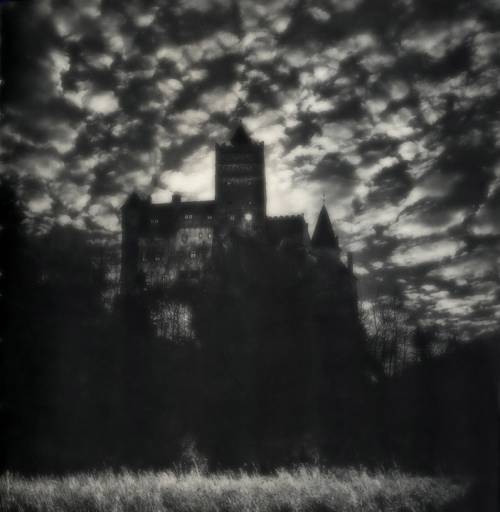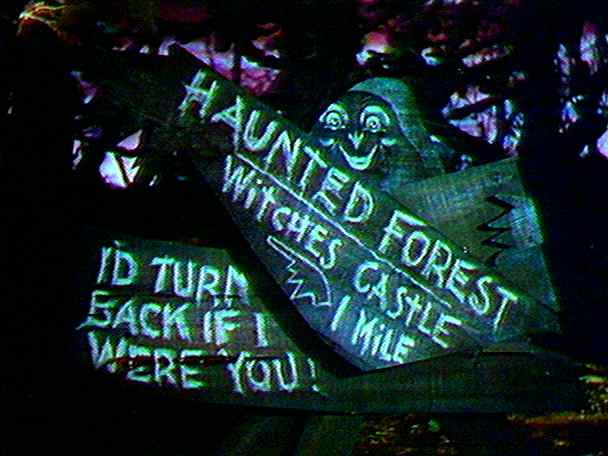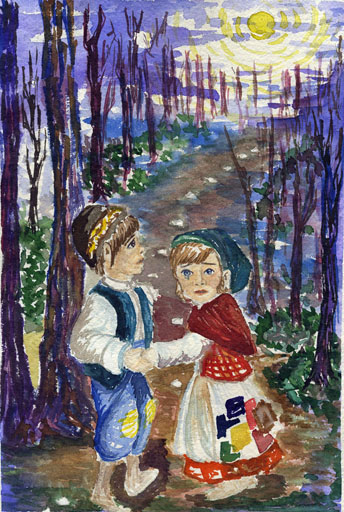|
the Gothic  (thanks to Anthony Ramsden 2008) |
Craig White's Literature Courses
|
|
including the Wilderness Gothic >> |
 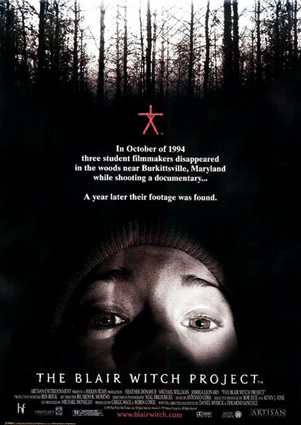 |
The gothic is a genre or style of literature that appears throughout Western literary history—from visions of hell to the novels of Stephen King—though it often goes by names like "horror," "terror," "thriller," the grotesque or macabre.
The gothic is easily identified by its network or system of symbols, all of which may not appear in every text:
![]() haunted houses / castles / woods
haunted houses / castles / woods
![]() mazes, labyrinths
mazes, labyrinths
![]() closed doors & secret passages / rooms
closed doors & secret passages / rooms
![]() light and dark interplay with shades of gray or blood-red colors (color
code)
light and dark interplay with shades of gray or blood-red colors (color
code)
![]() fair & dark ladies
fair & dark ladies
![]() twinning, doubling, &
doppelgangers
twinning, doubling, &
doppelgangers
![]() repressed fears & desires;
memory of past crime
or sin
repressed fears & desires;
memory of past crime
or sin
![]() death & decay
death & decay
![]() bad-boy
Byronic
heroes
bad-boy
Byronic
heroes
![]() blood as visual spectacle and genealogy / ethnicity
blood as visual spectacle and genealogy / ethnicity
![]() spectral or
grotesque figures, lurid symbols
spectral or
grotesque figures, lurid symbols
![]() creepy or startling
sounds,
screams in the night, groans from locked rooms
creepy or startling
sounds,
screams in the night, groans from locked rooms

Manifestations of the gothic make a long list, and so do its literary genres:
-
gothic novels or
romances, horror, thrillers, mysteries,
film noir
-
“goth” fashion and gothic rock or metal music
- Frequently today (and earlier) the
gothic is satirized as a formula,
e.g.
The Addams Family,
Young Frankenstein,
Scary Movie, etc.
-
The gothic has deep roots in theology, architecture, psychology, the
imagination, and many literary traditions. (see
variations on the gothic)
-
Backgrounds:
Images associated with the gothic stretch back to
Christian visions of hell,
devils, and demons, with Lucifer as the original Byronic hero: proud,
rebellious, attractive, dangerous to know. As the gothic develops,
such imagery
becomes secularized but may still evoke the supernatural.
-
The
indispensable feature of nearly any gothic narrative is a
haunted space that
reflects or corresponds to a haunted mind. In European literature the gothic
space is typically a haunted castle or other architectural structure such as
a
maze or labyrinth. In science fiction such a
space may be a haunted spaceship with intricate passageways, as in Alien
(1979) or a hive or colony of insect-like vampires as in Priest
(2011).
-
Psychological / cultural projections of the
gothic:
- Especially in Poe but also in
Bronte's Jane Eyre
and other gothic fiction, the haunted space appears as a
correspondence or projection of a
haunted mind. This psychological reading of the gothic would account for
the style's persistence across various periods, media, and cultures.
- The darkness and irrationality
of the gothic villain or setting may sometimes serve as a convenient
characterization of the Other or the
Unknown. For instance, in Charlotte Bronte's
Jane Eyre (1847)
the Creole woman Bertha from the Caribbean is characterized in terms of
gothic darkness and uncontrolled passion and depravity, in contrast to
the pale, English, and restrained Jane. Comparably, in early
American literature Native American Indians are sometimes described as
"black" or "dark" figures holding satanic ceremonies in the night.
- Though demonic elements of
the gothic are easily observed, more positive spiritual elements
often escape attention. The gothic's darkness depends on a corresponding
light; the fair lady must be offset by a dark lady. Following the
release of the 1973 film The Exorcist,
church attendance enjoyed a temporary bump. Fascination with darkness requires an idea of light.
- Especially in Poe but also in
Bronte's Jane Eyre
and other gothic fiction, the haunted space appears as a
correspondence or projection of a
haunted mind. This psychological reading of the gothic would account for
the style's persistence across various periods, media, and cultures.
![]()
"The Wilderness Gothic"
|
American literature may feature gothic buildings like Faulkner’s or Morrison's ruined plantation mansions or Steven King's Overlook Hotel in The Shining (1977), but . . . American literature and films often transfer the gothic to a haunted forest or wilderness—from The Legend of Sleepy Hollow and The Last of the Mohicans to The Blair Witch Project. William Faulkner's fiction of the deep South sometimes sets gothic effects in houses, as in the Poe-like A Rose for Emily, but in texts like "The Bear" or "The Old People" in Go Down, Moses (1942), the American forest (or "jungle") appears as a maze-like mystery to which a young innocent is initiated. The haunted forest may be traced back to European fairy tales like Hansel & Gretel or tales of knights crossing unknown territories. Gothic literature in the early United States faced a peculiar problem with settings, however. European gothic tales typically featured a mysterious mansion, castle, or abbey. The American landscape had few or none of these ancient buildings with time-haunted memories of crime and betrayal. So American writers used the American landscape: Imagination peoples the unknown with threats that are symbolized by familiar images—for European colonists and their descendents, such threatening images might be darkness, demons, the innocent imperiled. Early European-American settlers sometimes regarded the New World as "the Devil's Territories" (Cotton Mather) and the Native Americans as either serving the devil, or devils themselves. And then there's the guilt of repressed crime or sin that the gothic explores. America's original sin may have been taking the land from its original inhabitants and reducing them through disease, war, and exploitation.
Other examples of Wilderness Gothic: Harper Lee, To Kill a Mockingbird (1960) The
Blair Witch Project
|
|
![]()
![]()
The Gothic Novel
 |
 |
The Gothic Novel
Definitions:
"Gothic." A term for aspects of medieval art first applied to pointed architecture in the early seventeenth century. . . . The gothic revival [in architecture in the seventeenth and eighteenth centuries] in its literary aspects was closely associated with the green copses, disordered stone piles, enchanting shadows and sweet melancholy of these ruined buildings. . . . Horace Walpole built Strawberry Hill (1750-53) and wrote The Castle of Otranto (1764) in the same mood.--Joseph T. Shipley, ed. Dictionary of World Literary Terms. Boston: The Writer, Inc., 1970.
"The Gothic Novel." A form of novel in which magic, mystery, and chivalry are the chief characteristics. Horrors abound: one may expect a suit of armor suddenly to come to life, while ghosts, clanking chains, and charnel houses impart an uncanny atmosphere of terror.--C. Hugh Holman, A Handbook to Literature, 3d. ed. Indianapolis: Odyssey, 1972.
“Gothic Fantasy": The starting point of Gothic literature is usually given as The Castle of Otranto (1765) by Horace Walpole . . . . Although all Gothic fiction is tragedy, its key component is the edifice [or building] . . . . Gothic fiction usually takes place in an ancient castle or abbey whose owner discovers his noble line is doomed, usually because some past misdemeanor has caused the family to be cursed. . . . [The genre] was desensationalized and adopted into the mainstream by Charlotte Bronte in Jane Eyre (1847) and Emily Bronte in Wuthering Heights (1847). . . . [In the late 19th and early 20th centuries] the Gothic mode shifted toward romantic fiction, and was revived strongly in the work of Daphne du Maurier, who built on the work of the Brontes to lay the foundation for the modern Gothic romance. . . .--Mike Ashley, “Gothic Fantasy,” The Encyclopedia of Fantasy, eds. John Clute and John Grant. NY: St. Martin’s Press, 1997.
Additional examples of genre: See titles above, plus Ann Radcliffe, The Mysteries of Udolpho (1800?); Mary Shelley, Frankenstein (1818); Edgar Allan Poe, "The Fall of the House of Usher" (1839); Bram Stoker, Dracula (1897); Daphne du Maurier, Rebecca (1938); Anne Rice, Interview with the Vampire (1976); Stephen King, The Shining (1977)
 |
 |
![]()
categories
of gothic
European / psychological gothic
-
haunted castles or ancient houses as reflections of haunted mind
-
examples: Poe, Anne Rice, some Stephen King (Americans, but locate gothic in older parts of country)
-
+ European predecessors (Walpole, Radcliffe, Lewis)
Wilderness
gothic—Irving's "Sleepy Hollow" & "Rip Van Winkle," Cooper, The
Last of the Mohicans; also To Kill a Mockingbird, Blair Witch Project
Puritan / moral gothic—Hawthorne, Scarlet Letter and stories (also include some wilderness gothic)
Space
gothic—Alien(s)
Suburban
gothic—Nightmare on Elm Street
Urban gothic—film noir (dark detective films like The Big Sleep, The Maltese Falcon, Chinatown, Body Heat, LA Confidential)
Links to gothic websites
Gothic Architecture of the High Middle Ages
Research Sources: See above, plus web sites: The Gothic Literature Page http://members.aol.com/FranzPoet/intro.html
Literature of the Fantastic (gothic novels on-line, mostly out-of-copyright tales from the nineteenth century) http://www.sff.net/people/DoyleMacdonald/lit.htm
Final exam essay from LITR 4232 American Renaissance question: Describe the characteristics and significance of the Gothic . . .
[complete answer]
The Gothic novel is a stylistic mode or genre that uses a set
of conventions to instill a feeling of fear, or uneasiness in the reader.
These conventions could include, but are not limited to haunted spaces,
light and dark, pointed architecture, and masks. Gothic novels
traditionally used Europe as their setting, as we will see with Poe, but
throughout the course we had the pleasure to see it imported to American
towns, woods, and even the human mind. In this mode, the Gothic can
work towards setting the mood of the reader towards the works as a whole, or
more importantly, we saw that it can be used to help us examine our own haunted
spaces. As you mentioned several times in the class, we all have our secrets and
we all wear our masks. Good writing helps us to see beyond our own masks.
We were introduced to the Gothic very early in our reading.
Washington Irving used the gothic throughout both "The Legend of Sleep
Hollow", and "Rip Van Winkle." When viewing Irving as a popular
writer who was adopted into the world of classical literature, I would guess
that Gothic exists in his work simply to enhance the setting. While RVW may be
viewed as a statement on his society, I wonder how political he actually meant
it to be. On page 1369 we are given a scene that is very Gothic. Ichabod has
made his way into the woods on a dark and lonely night. During this trip he
recalls stories of ghost and goblins. He eventually makes his way to the tulip
tree and sees its twisted and knarled form. The tree actually moans at him at
one point. Again, this type of writing does well for setting the mood but I did
not find that it urged me to think or examine myself. I do not mean to speak ill
of his works, they used the Gothic well and have obviously withstood the test of
time.
The second reading that we saw the Gothic in was The Last
of the Mohicans by James Fenimore Cooper. Cooper used the Gothic heavily in
both the setting, as a wilderness gothic, and as a very important tool where the
Gothic worked to show the returning past as repressed. Throughout the novel we
often visit ruins that are "quietly crumbling in the solitude of the forest,
neglected, and nearly forgotten…(125)" there are also several graves that
appear. During their adventure we are often reminded that horrible
actions have taken place in the past. (I’m getting bogged down so let
me be more general.) We are also show Gothic of a matter of light and
dark. This applies to both physical lighting and the shades of skin.
Cooper uses Gothic for describing physical locations. For example, the cave in
Glenn’s falls we see the secret doors and its jagged edges. Again, this usage of
Gothic by Cooper shows the past being revisited and demonstrates the ghost-like
state of the Indians. He uses Gothic to explain the situation of a particular
group of people.
When one thinks of Gothic, Poe is often the first writer that
comes to mind. Because of his writing style, he is often perceived as demented
or insane. This is due to the fact that people easily mistake Poe as a writer
using the Gothic, with the "I" character he inserts into his works. As I
mentioned earlier, Poe often wrote with the traditional Gothic setting, Europe.
However, his use of the Gothic as a mode extends past settings or establishing
an attitude in the reader. He uses the Gothic as the subject of his works. When
Poe includes a Gothic space in his writing, for example a house, it usually
parallels or corresponds with the unconscious mind of the reader or the
characters in the works. One page 1461 in "The Fall of the House of Usher"
we see that the house has vacant eye-like windows and on 1462 we are
presented with the fact that the house is identified along with the family. This
technique of twinning is another common occurrence in the Gothic. Once this
convention is identified, the reader can see that whatever the family is going
will be reflected on the house and likewise. Twinning also appears with the
Roderick and Madeleine twins. There seems to be almost a supernatural connection
between the individuals (if they are indeed that). With Poe we do also get the
generic Gothic. In the "City in the Sea" (1507) we are presented with decaying
towers. Again, Poe seems to use the traditional European gothic but in a way
that comments on the psychological state of the characters and the reader.
Hawthorne contains most of the Gothic conventions named
earlier but he seems to most use the Gothic as a commentary on the degrees of
guilt and innocence possessed by all humans. He uses the light and dark to
represent good and evil. He also makes it clear that even in the Gothic there
does exist shades of gray. Unlike the other writers, Hawthorne sets his works in
the Puritan times. This choice allows him to take advantage to the ideas of
traditional good and evil and to interject his exploration of the subject in a
way that shows there is no absolute right and wrong. Like Cooper and Irving, he
often writes in the wilderness Gothic. One 2208 Goodman Brown takes a "dreary
road, darkened by all the gloomiest trees of the forest…" but this also ties
into Poe’s use of Gothic in that the road taken corresponds to his actions.
Hawthorne most uses the "Puritan Gothic" where is customarily making a walk to
the graveyard to reflect upon live. In the Minister’s Black Veil he uses
the veil as a mask to cover his sins. The reference to secret sin is very
strongly in turn with the Puritans. Even the wilderness gothic is provided for
under the puritan thinking in that the wilderness is considered heathen (2211).
He was also very good at connecting correspondence as a Gothic convention. On
page 2222 the use of a cloud and the sunshine correlates to sin and sorrow.
The last writer that I will
cover (briefly) is Melville. In Billy Budd we have Claggart as the gothic
character. He is the darker of the characters in appearance and nature. He seems
to like Billy but is drawn to harm him. The powers of his actions are out of his
control. On page 2543 Claggart is described as having manifestations and a
subterranean fire that was eating away at him. In his writing, Melville seemed
to use the gothic in relation to a single person and not the society as a whole
or even the setting of the novel. This is an example of a very focused Gothic.
[DG 2001]
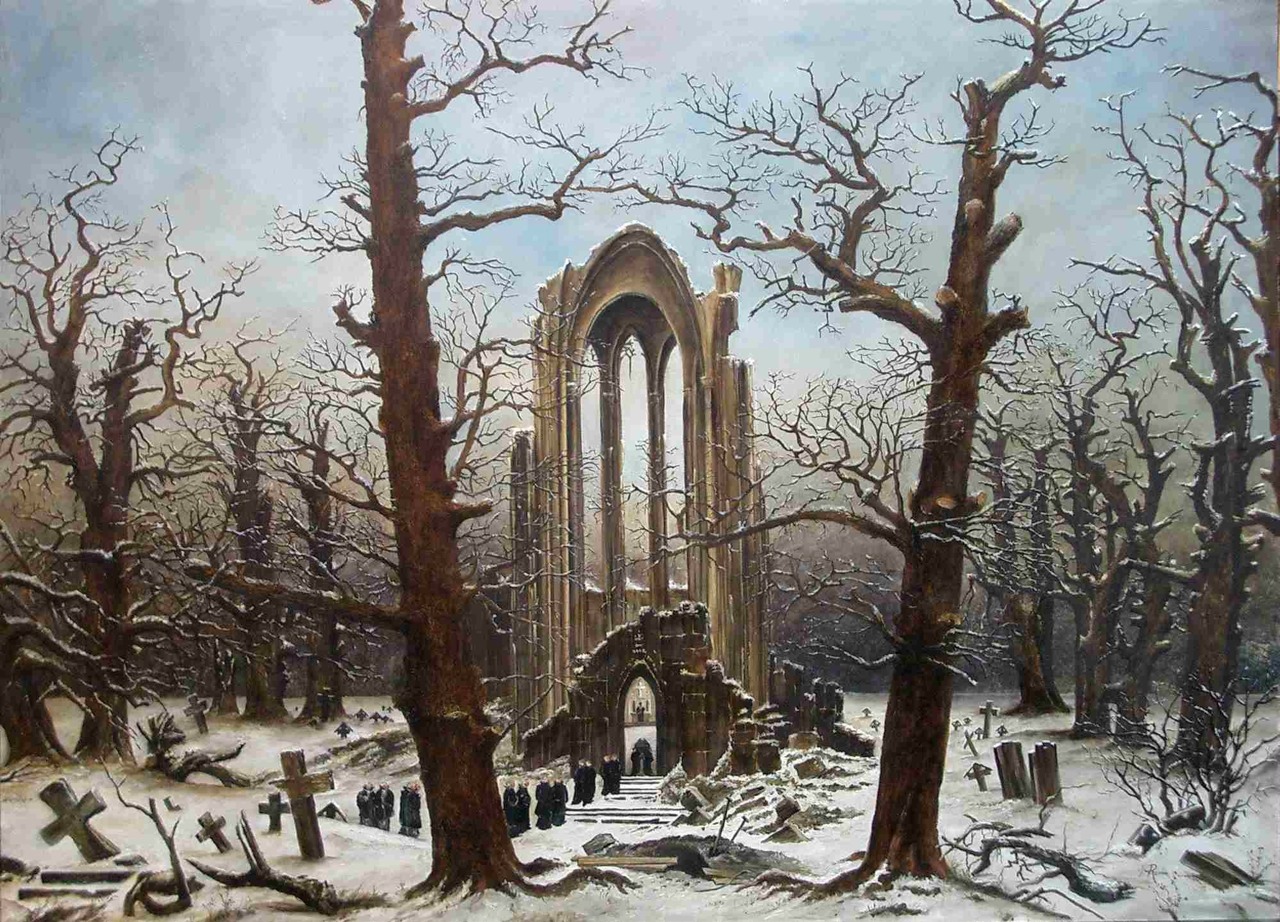
Caspar David Friedrich,
Abbey in the Oak Forest
(1810)
Gothic features
include gothic arches, light-dark contrast, decay, graves, monks, ruins, etc.

